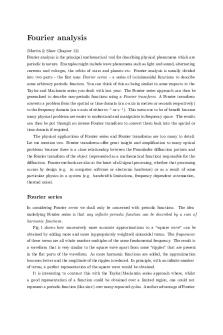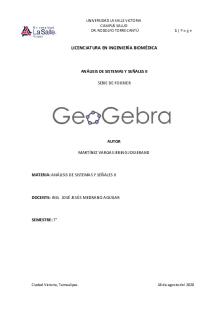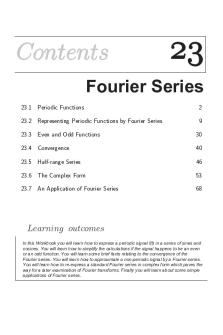MATE2A2 Introduction Fourier Series lecture notes PDF

| Title | MATE2A2 Introduction Fourier Series lecture notes |
|---|---|
| Author | Tylo Stols |
| Course | Mechanical Engineering |
| Institution | University of Johannesburg |
| Pages | 16 |
| File Size | 403.4 KB |
| File Type | |
| Total Downloads | 104 |
| Total Views | 143 |
Summary
Lecture notes introducing the student to Fourier series , including the methodology and examples for representing the series...
Description
University of Johannesburg Faculty of Science Department of Mathematics and Applied Mathematics Lecturers: SM Simelane, IK Letlhage & V Sixaba
Introduction to Fourier Series 1. Introduction Fourier series are infinite series that were designed to represent a periodic function in terms of simple ones, namely the sine and/or cosine terms. Fourier analysis has its most important applications in modeling as well as solving of both ordinary differential equations (ODEs) and partial differential equations (PDEs) related to boundary and initial value problems of mechanics, heat flow, electrostatics, and other fields. Fourier analysis allows us to model periodic phenomena which appear frequently in engineering and elsewherethink of rotating parts of machines, alternating electric currents or the motion of planets. More applications include CAT scans, computing and data compression, vibration analysis, acoustics, optics, signal and image processing, astronomy and many more. For instance, in astronomy, astronomers are able to deduce the chemical composition of star by analyzing the frequency components, and/or spectrum of the star’s emitted light. The discovery of Fourier series had a huge impetus on applied mathematics as well as on mathematics as a whole. Indeed, its influence on the concept of a function, on integration theory, on convergence theory, and other theories of mathematics has been substantial.
2. Definition Fourier series are infinite series that represent periodic functions in terms of cosines and sines. To define Fourier series, we first need to recall some of the concepts we know from first year mathematics. A function f (x) is periodic if its values repeat itself at constant intervals of x. The constant interval between repetitions is called the period of f (x), denoted by p. Algebraically, a periodic function is defined as f (x) = f (x + p). The equation above means that the function value at any x value is equal to the function value at another x value p units away from x. The graph of a periodic function has the characteristic that it can be obtained by periodic repetition of its graph in any interval of length p (see figure 1).
Figure 1: An example of a periodic function 1
We know that f (x) = sin x and f (x) = cos x are periodic with period p = 2π. Hence we can represent f (x) as f (x) = f (x + 2π). Graphically,
(a )
(b)
Figure 2: (a) f (x) = sin x.
(b) f (x) = cos x.
The graph of f (x) = sin2x has a smaller period, the period is now p = π.
Figure 3: f (x) = sin 2x If f (x) has period p, then for any integer n = 1, 2, 3, ... f (x) = f (x + np). Further more, if f (x) and g(x) have period p, then a f (x) + bg(x) with any constants a and b also has the period p. The smallest positive period is often called the fundamental period. Familiar periodic functions are the cosine, sine, tangent, and cotangent. Examples of functions that are not periodic are x, x2 , xn , ex , cosh x, ln x, etc. Consider the function f (x) = sin x, we observe the following • f (x) = sin x gives rise to the largest period, p = 2π. This is known as the first harmonic of sine. • f (x) = sin 2x gives rise to a smaller period, p =
2π = π. This is known as the second harmonic of sine. 2
2π . This is known as the nth harmonic of sine. n We use the harmonics of sine and cosine to present a periodic function as an infinite series. • Generally, f (x) = sin nx has the period p =
2
3. Integrals The calculation of a Fourier series involves the integration of sine and/or cosine functions and is combinations. Therefore, we recall some basic concepts on integration that we encountered in MATE1A1 and MATE1B1. Multiples of cos nx and sin nx play an important role in the evaluation of certain definite integrals. We highlight and emphasize the following (make a mental note of these values): 3.1. Multiples of sine
Figure 4: f (x) = sin x Reading of f the values from the graph of f (x) = sin x above, we make the following conclusions • sin nπ = 0
for all n ∈ N or n = 1, 2, 3, ...
• Similarly, sin 2nπ = 0
for all n ∈ N or n = 1, 2, 3, ...
π • With intervals of , the values oscillate between -1, 0 and 1. i.e. 2 n = even 0 nπ sin = 1 n = 1, 5, 9, . . . 2 −1 n = 3, 7, 11, . . .
3.2. Multiples of cosine
Figure 5: f (x) = cos x From the graph of f (x) = cos x, we conclude that 3
• cos nπ =
(
n = odd n = even
−1 1
• Similarly, cos 2nπ = 1
for all n ∈ N or n = 1, 2, 3, ...
π • With intervals of , the values oscillate between -1, 0 and 1. i.e. 2 n = odd 0 nπ cos = −1 n = 2, 6, 10, . . . 2 1 n = 4, 8, 12, . . .
We use the above defined/mentioned values to evaluate some integrals and later the Fourier series. 3.3. Worked out examples Evaluate the following 1. Z
0
2. Z
0
π 2
π
Z 1 π n sinnx dx n 0 1 π = − cos nx 0 n 1 = − (cos nπ − cos0) n cos nπ is either 1 or -1 and cos0 = 1 ( −1 − 1 n = odd 1 =− n 1−1 n = even 2 n = odd n = 0 n = even
sin nx dx =
Z π2 1 n cos nx dx n 0 π 1 = sin nx 02 n nπ 1 − sin0) = (sin n 2 sin0 = 0 and sin 2π is either 0, 1 or -1 n = even 0 1 = 1 n = 1, 5, 9, .... n −1 n = 3, 7, 11, ...
cos nx dx =
4
3. Z
0
2
cos
Z 2 nπx 2 nπ nπx cos dx dx = 2 2 2 nπ 0 2 nπ x 2 = sin nπ 2 0 ! 2 2nπ = − sin0 sin 2 nπ 2 (sin2nπ − sin0) = nπ sin nπ = 0 and sin0 = 0 =0
4. Z
0
−1
5.
Z 0 1 sin nπx dx = n sin nπx dx nπ −1 1 0 = − cos nπx −1 nπ 1 = − (cos0 − cos(−nπ)) nπ cos0 = 1 and cos(−β)=cos(β) ( 1 − (−1) n = odd 1 =− nπ 1 − 1 n = even 2 n = odd − nπ = 0 n = even Z
0
2x cos nx dx −π
We have a product of two functions of x, and so we use integration by parts (I BP). We let dv = cosnx 1 v = sinnx n
u=x du = dx Now, Z
0
−π
! Z 0 x 1 0 sinnx −π − sinnx n n −π 0 ! 0 x 1 = 2 sinnx −π + 2 cosnx −π n n 2 2 = (0 − 0) + 2 (cos0 − cos(−nπ)) n n cos0 = 1 and cos(−β) = cos(β) ( 1 − (−1) n = odd 2 = 2 n 1−1 n = even 4 n = odd n2 = 0 n = even
2x cos nx dx = 2
5
6.
Z
π
x2 sin nx dx
−π
We have a product of two functions of x, thus we can use either integration by parts or the Kronecker’s method. We apply the Kronecker’s method for repeated integration by parts which states that Z ′ ′′ u v dx = u v1 − u v2 + u v3 − u′′′ v4 + . . . where v1 = To evaluate
Rπ
−π
Z
v dx,
v2 =
Z
v3 =
v1 dx,
Z
v2 dx,
v4 =
Z
v3 dx . . .
x2 sin nx dx using the Kronecker method, we let u = x2 and v = sin nx. Then u = x2 ,
′
u = 2x,
′′
u = 2,
′′′
u =0
Z
1 sin nx dx = − cos nx n Z Z 1 1 v2 = v1 dx = − cos nx dx = − 2 sin nx n Z n Z 1 1 v3 = v2 dx = − 2 sin nx = 3 cos nx n n v1 =
Thus Z π −π
′
′′
x2 sin nx dx = u v1 − u v2 + u v3 ! ! ! π 1 1 1 = x2 − cos nx − 2x − 2 sin nx + 2 3 cos nx −π n n n ! 2(−π) 2π 2 2 π2 π2 cos(−nπ) + cos nπ + sin(−nπ) + 3 cos(−nπ) sin nπ + 3 cos nπ − − =− n n n2 n2 n n Recall that sin(−β) = - sin(β) and sin nπ = 0 =−
π2 π2 2 2π cos nπ + 3 cos nπ + cos nπ − 3 cos nπ n n n n
=0
Exercise 1 Determine the following integrals: Rπ 1. 0 cos nx dx 2.
R0
−3
sin
nπ x dx 3
2 Rπ cos x sin nx dx π 0 Rπ 4. −π x2 cos nxdx
3.
(Hint: use an identity).
6
4. Fourier Expansion This section is covered in section 11.2 in the Trench textbook (page 587). Suppose the function f (x) is periodic, then the Fourier series of a periodic function f (x) with period p is given by f (x) = a0 +
∞ X
an cos
n=1
2nπ x 2nπ x + bn sin p p
!
(4.1)
where Z 1 f (x) dx p Z 2nπ x 2 dx f (x)cos an = p p Z 2 2nπ x bn = dx f (x)sin p p
a0 =
integrate over the complete period p
(4.2)
integrate over the complete period p
(4.3)
integrate over the complete period p
(4.4)
a0 , an and bn are called the Fourier coefficients. Should the function f (x) be defined overRthe interval (0, p), then we p always perform the integrals given above from zero (lower limit) up to p (upper limit) i.e. 0 f (x) dx. If f is integrable on [−L, L], then the period becomes p = L − (−L) = 2L. Substitute p = 2L, then the Fourier series becomes ∞ X nπ x nπ x + bn sin f (x) = a0 + an cos (4.5) L L n=1
where Z L 1 f (x) dx 2L −L Z L nπx 1 dx f (x)cos an = L L −L Z L nπ x 1 f (x)sin bn = dx L L −L a0 =
which is exactly the same as the formula in Trench, as well as most books in literature. Also note that if we let Z 2 a0 = f (x) dx , p
(4.6) (4.7) (4.8)
(4.9)
then the Fourier series becomes ! ∞ 2nπ x 2nπ x a0 X an cos + + bn sin . f (x) = 2 n=1 p p
(4.10)
The 2 in the denominator in a0 will cancel out with the 2 in f (x), simplifying back to equation 4.12. Another way to write the series 4.12 is by using the relationship acosωx + bsinωx = Rsin(ωx + α) (in MATE1A1) i.e. f (x) = a0 + R1 sin(x + α1 ) + R2 sin(2x + α2 ) + R3 sin(3x + α3 ) + . . . + Rn sin(nx + αn ), where a0 is constant and q
an2 + b2n are the amplitude , an αn = tan−1 are the phase angle. bn Rn =
7
(4.11)
For the series of equation 4.12, the term a1 cosx + b1 sin x = R1 sin( x + α1 ) is called the first harmonic or the fundamental. a2 cosx + b2 sin x = R2 sin( x + α2 ) is called the second harmonic, and so on. For an exact representation of a complex wave, an infinite number of terms are, in general, required. In many practical cases, however, it is sufficient to take the first few terms only. The sum of a Fourier series at a point of discontinuity is given by the arithmetic mean of the two limiting values of f (x) as x approaches the point of discontinuity from the two sides. For example, for the waveform shown in Fig. 6, the sum of the Fourier series at the points of discontinuity (i.e. at 2π, π, . . .) is given by 8 + (−3) 5 = 2 2
Figure 6 For the purpose of these notes, we will adopt the formulas 4.12-4.4. However, you are free to use any of the formulas which you are comfortable with. Worked out examples Example 7: Find a Fourier series for the periodic function ( 3 f (x) = 0 if f ( x) = f ( x + 2π). Solution: A sketch of this function is given below
8
0≤x...
Similar Free PDFs

Fourier series Lecture Notes
- 24 Pages

4(Fourier Series) - Lecture notes 4
- 15 Pages

Series de Fourier
- 11 Pages
Popular Institutions
- Tinajero National High School - Annex
- Politeknik Caltex Riau
- Yokohama City University
- SGT University
- University of Al-Qadisiyah
- Divine Word College of Vigan
- Techniek College Rotterdam
- Universidade de Santiago
- Universiti Teknologi MARA Cawangan Johor Kampus Pasir Gudang
- Poltekkes Kemenkes Yogyakarta
- Baguio City National High School
- Colegio san marcos
- preparatoria uno
- Centro de Bachillerato Tecnológico Industrial y de Servicios No. 107
- Dalian Maritime University
- Quang Trung Secondary School
- Colegio Tecnológico en Informática
- Corporación Regional de Educación Superior
- Grupo CEDVA
- Dar Al Uloom University
- Centro de Estudios Preuniversitarios de la Universidad Nacional de Ingeniería
- 上智大学
- Aakash International School, Nuna Majara
- San Felipe Neri Catholic School
- Kang Chiao International School - New Taipei City
- Misamis Occidental National High School
- Institución Educativa Escuela Normal Juan Ladrilleros
- Kolehiyo ng Pantukan
- Batanes State College
- Instituto Continental
- Sekolah Menengah Kejuruan Kesehatan Kaltara (Tarakan)
- Colegio de La Inmaculada Concepcion - Cebu












